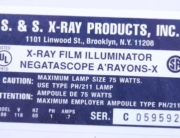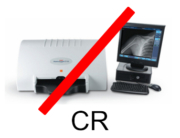ITN magazine published a story about the recent legislation and reimbursement rates for film, CR and DR. This, as you know, has been a topic of interest of mine.
Greg Freiher’s article, “The Coming Push for DR,” (http://www.itnonline.com/article/coming-push-dr-2) contains a fair description of the US Congress’ 2015 law to impose penalties for the continued use of x-ray film and CR digital technology. However, it does not address the critical issue of whether this is a good or appropriate law.
This is my reply I hope they publish.
The article helps to reinforce the myth that only DR digital technology is an effective “go forward” solution for healthcare providers. In fact, forcing the change to DR adds unnecessary costs and revenue reductions for a large segment of providers. In addition, it can result in significant increases in radiation dose for patients.
The 2015 legistration was initially proposed by a DR manufacturer, and it was heavily promoted by MITA the large equipment manufacturers’ trade association. It was subsequently supported by the American College of Radiology who joined the effort in order to fight fee reductions for their members for second read rates.
Lobbying for these changes is neither illegal nor unethical, but in implying that CR is worse than DR and pushing for a reduction in its reimbursement rates, these groups have done a disservice to our industry. Here are the key reasons:
- Freiher’s article infers that DR provides a lower radiation dose than CR. This is not universally true. The law makes no distinction between DR technologies and it is well-known that CCD-based systems require much more radiation than most CR systems. While the primary objective of medical care is to “do no harm,” this creates incentives for medical providers which conflict with the best interests of the patient.
- Freiher’s article cites “experts” who claim that DR provides a major workflow improvement and implies that this is a universal benefit throughout the healthcare system. Again, this is untrue. While the argument can be made DR might reduce staff needs (FTE’s) for very busy hospitals, the same cannot be said for small to middle size healthcare providers, including private practices, urgent care facilities and even small regional hospitals. Reductions of fractional FTE’s may add up to one less technical staff member at a large hospital but that savings will not accrue to a small practice that does a modest number of studies on a daily or weekly basis. The few minutes per day in technical time these facilities will save is meaningless and will not reduce their staffing requirements. Even more important, the cost to upgrade from CR to DR may never be cost-justified based on their study volumes.
 Below is a chart that sets forth what I believe are the current technical reimbursement rates and the reductions that will be imposed on CR, assuming the rates stay the same over the next few years. I also have included film in the chart as it is relevant for the second half of this blog.
Below is a chart that sets forth what I believe are the current technical reimbursement rates and the reductions that will be imposed on CR, assuming the rates stay the same over the next few years. I also have included film in the chart as it is relevant for the second half of this blog.
| CPT Code | Study of: | Technical Rate | 7% CR Reduction | 20% Film Reduction |
| 73030 | Shoulder | $35.80 | $2.51 | $7.16 |
| 73111 | Wrist | $35.80 | $2.51 | $7.16 |
| 74000 | Abdomen | $35.80 | $2.51 | $7.16 |
| 71111 | Ribs/Chest | $35.80 | $2.51 | $7.16 |
Since these studies have the same reimbursement, “breakeven” years (assuming various numbers of total studies per year) are easy to calculate.
| Annual Studies | Reduction in Reimbursement Because Using CR | DR Upgrade Breakeven Point in Years** |
| 1,000 | $2,510 | 15 years 10 months |
| 2,500 | $6,275 | 6 years 4 months |
| 5,000 | $12,550 | 3 years 2 months |
| 10,000 | $25,100 | 1 years 9 months |
| 25,000 | $62,750 | 7 months |
** One dealer estimated that with service and drop insurance added, the cost of a DR upgrade could be as much as $40,000, even after the CR “trade in” value was considered. If you think that is too high or too low, change it. Also you might add in “tax savings” due to new equipment depreciation although I think of this as false savings. (I’d rather have the money in my pocket.) All time periods are rounded down to the nearest month.
I believe that a good case can be made to encourage providers to go digital. The primary reason, not stressed in Mr. Freiher’s article, is that digital images can be easily added to electronic medical records and thereby be made accessible for patient care by all involved medical experts. A second reason is that digitizing images allows use of machine based reviews, detections and diagnostic software that may lead to better patient care. A third reason, mentioned by Mr. Freiher is the potential for radiation dose reduction. The recording of that important information in the patient’s record can help monitor the “do no harm” objective. (The word “potential” is important to emphasize because since digital imaging is so efficient and since it removes the consumable costs related to film based x-ray, there may be a bias to do more imaging rather than less. In searching the internet I have not found any studies directly addressing this issue, but it would be interesting to find out if this has been observed.)
Those of us in the equipment sales area of imaging can tell you that the 2015 legislation has already “taxed” our citizens unnecessarily. As soon this law became known, there was an immediate and significant drop in sales of CR systems. The market is now flooded with CR systems being turned in for higher cost DR systems as all sizes of healthcare providers faced the potential loss of reimbursements. And much of this increased purchasing was, I believe, quite unnecessary and undesirable. Consider the charts above again and study the small loss of reimbursement for CR studies. I submit that these losses do not justify the purchase of new DR equipment for small and medium practices.
You might ask why a medical equiment sales professional would write this letter. I directly benefit from this sales frenzy. Why bite the hand that feeds me?
The answer is that I’m also a business owner who pays for medical care coverage and a taxpayer who is effectively subsidizing these unnecessary purchases. I’m also a person who has watched for more than thirty-five years the unnecessary obsolescence of perfectly good technology just because something new is available.
This new law is troubling in its incentives and effects, and it should be rolled back. Articles about these new laws need to address all of their pros and cons, and ask the questions who pushed for these changes, what were the real motivations, and what policies promote the best patient care.








Well said, Daniel. Maybe someone that thinks they see the “big picture” will take the time to read the credits.
Don’t 100% agree with workflow not being a factor. I’ve witnessed elderly patients (specially in Ortho) having to spend 20 minutes being tossed around in discomfort in the x-ray room. With DR you immediately see if there’s any positioning or patient motion issues instead having to wait 2 minutes only to come back to re-shoot. A proper DR can be very effective in many areas. The holy grail is to have a good quality (low dose) DR at prices rivaling CR. We are 3-6 months away from this. Don’t throw the DR under the bus yet.
Sincerely, Joseph